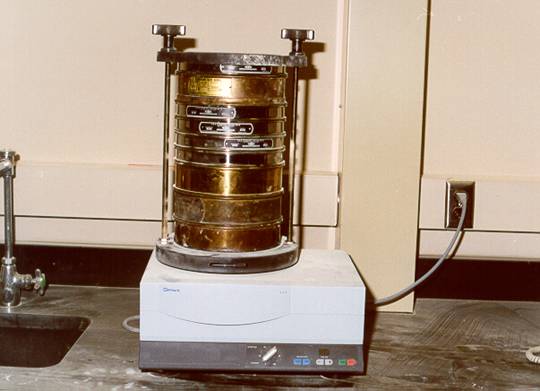Sieve Analysis of Coarse Grained Soil
The physical and mechanical properties and characteristics of fine-grained and coarse-grained soils are totally different. A geotechnical engineer has to understand these differences to select soils for construction purposes and to design safe and stable foundations (support systems) for structures that are to be supported on and within soils. For this purpose a process of sieve analysis is performed. To perform Sieve Analysis of Coarse Grained Soil following is the procedure:
Apparatus
A set of various sizes of sieves, balance.
Procedure for Sieve Analysis of Coarse Grained Soil
-
Arrange different types of sieves in order of there decreasing size of opening.
-
Find the total weight of the given soil sample and pour it in the top sieve.
-
Place the set of sieves on mechanical shakers and shake it properly.
-
Find the weight of soil retained on each sieve.
-
Calculate percentage weight of soil passing through each sieve.
-
Draw a grain size distribution/gradation curve.
-
Coarse-grained soils > #200 sieve; fine-grained soils < #200 sieve. Fine-grained soils are collected in the pan
Precautions:
 During shaking soil sample should not be allowed to spell out.
During shaking soil sample should not be allowed to spell out.- All the readings should be noted carefully.
Practical applications
- Grain size analysis gives an idea regarding the gradation of soil.
- It is used to proportion the selected soil in order to obtain the desired soil mix.
- It is also utilized in part of the specification of soil for air field’s roads, earth dams and other soil embankment construction.
Observations & Calculations:
| Sieve no. | Weight of soil retained on each sieve (gm) | Percent weight retained | Cumulative percent weight retained | Cumulative percent passing |
| 04 | 181.8 | 36.36 | 36.36 | 63.64 |
| 08 | 91 | 18.2 | 54.65 | 45.44 |
| 16 | 99.6 | 19.92 | 74.48 | 25.52 |
| 30 | 55.33 | 11.066 | 85.55 | 14.45 |
| 50 | 46.8 | 9.36 | 94.91 | 5.09 |
| 100 | 10.3 | 2.06 | 96.97 | 3.03 |
| 200 | 9.6 | 1.92 | 98.89 | 1.11 |
| pan | 4.8 | 0.96 | 99.85 | 0.15 |













